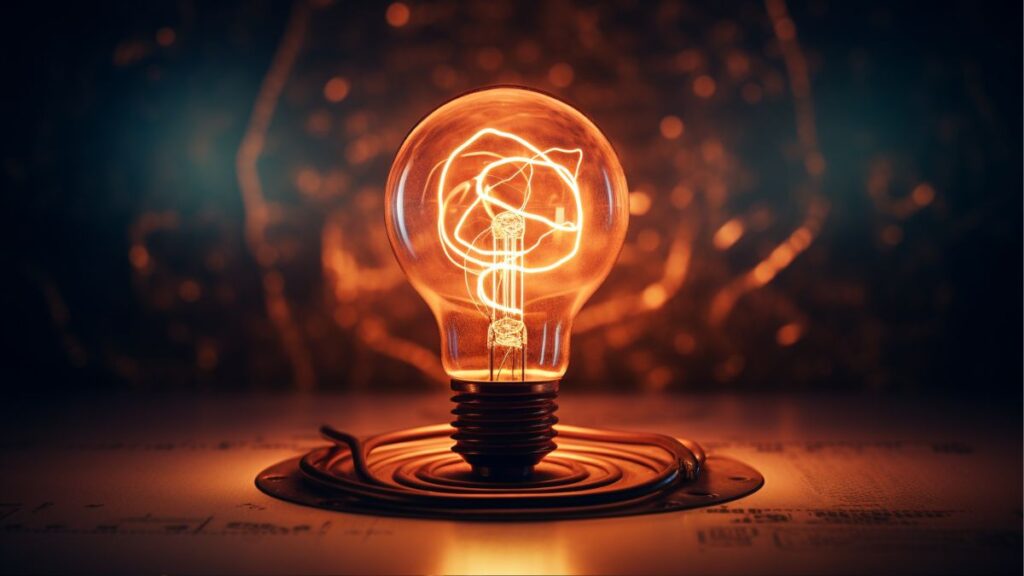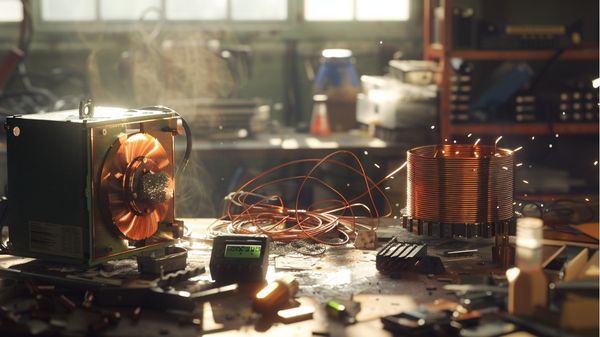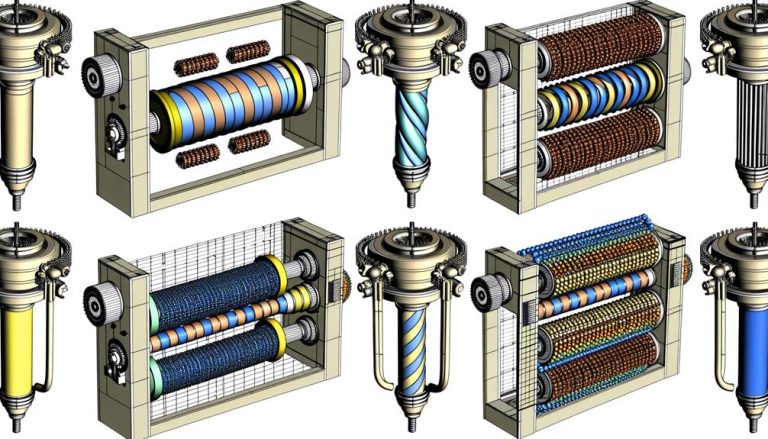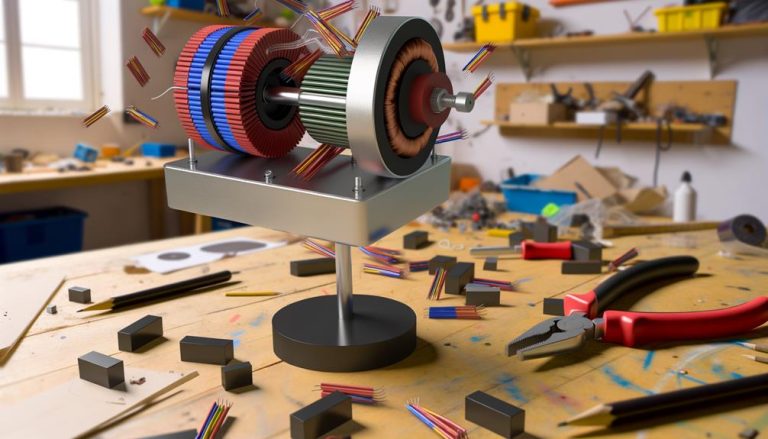Have you ever wondered how magnets and electricity work together to create a dynamic relationship? Let’s dive into the fascinating world of magnetism and its connection to electricity.
Imagine a scenario where you need to power a small device, like a flashlight, in a remote area without access to electricity. In this case, you can harness the power of magnets to generate electricity and light up your surroundings.
How is this possible? Well, it all comes down to the fundamental properties of magnets and their ability to create magnetic fields. By rapidly moving a magnet through a coil of copper wire, you can induce a flow of electrons, resulting in the generation of electricity.
The interaction between magnetic fields and moving electrons enables this remarkable phenomenon, highlighting the dynamic relationship between magnets and electricity.
In this article, we will explore the intricacies of this relationship, from understanding how magnets work to the role of electrons and the attraction and repulsion between magnetic poles. Get ready to be electrified by the fascinating world of magnets and electricity!

Key Takeaways
- Moving a magnet through a coil of copper wire creates a changing magnetic field strength, inducing a voltage in the wire.
- The strength of the magnetic field and the rate of movement of the magnet determine the amount of electric current generated.
- Magnets can be used to generate electricity through magnetic induction and rotating magnets in electromagnetic generators.
- Magnetic fields are created through magnetic induction, and their strength is determined by the number of aligned electrons.
The Dynamic Relationship
Magnets and electricity have a dynamic relationship as the movement of a magnet through a coil of copper wire can create an electric current. This phenomenon is known as magnetic induction or electromagnetic induction. When a magnet moves through the coil, it creates a changing magnetic field strength, which, in turn, induces a voltage in the wire.
This voltage can then be used to power various electrical devices. The strength of the magnetic field and the rate at which the magnet moves through the coil determine the amount of electric current generated.
Additionally, magnets play a crucial role in magnetic levitation, where the repulsive force between magnets is used to suspend an object in mid-air. Understanding the dynamic relationship between magnets and electricity is essential in comprehending how magnets work to generate electricity and power various technologies.
How Magnets Work
Imagine a world where tiny spinning electrons in objects align to create invisible forces that can pull and push things around. In this world, magnets play a crucial role in this dynamic relationship between magnets and electricity. Let’s dive into how magnets work.
- Magnetic induction: This process occurs when a magnetic field is created by a changing electric current. It’s like magic, as if the magnets themselves are talking to each other.
- Magnetic domains: Inside magnets, there are small regions called magnetic domains, where the spinning electrons align in the same direction. It’s like a perfectly choreographed dance party!
- Electromagnetic induction: When a magnet moves near a conductor, like copper wire, it creates an electric current. It’s like the magnet is teasing the conductor to dance to its rhythm.
Related Article: Harnessing The Power of Magnets: DIY Mini Generator for Endless Energy
Now, let’s explore how magnets create magnetic fields in the next section. Get ready to be amazed!
Creating Magnetic Fields
Get ready to witness the captivating power of magnetic fields as they create an invisible web of influence capable of defying gravity and moving objects with an enchanting force. Magnetic induction, a process in which spinning electrons in a magnet align to generate a magnetic field, is responsible for creating magnetic fields. The number of electrons and their alignment determine the strength of the magnetic field, which can be measured using a unit called magnetic flux.
To visualize a magnetic field, we can imagine magnetic field lines, which show the direction and intensity of the field.
Understanding the creation and behavior of magnetic fields is crucial in exploring the dynamic relationship between magnets and electricity. Speaking of which, let’s now delve into how magnets can be used to generate electricity.
Using Magnets to Generate Electricity
Get ready to witness the mind-blowing power of magnets as they work their magic and transform motion into a mesmerizing flow of electrifying energy! When it comes to using magnets to generate electricity, there are a few key concepts to understand.
First, magnetic induction is the process by which a changing magnetic field creates an electric current in a nearby conductor. This is the basic principle behind electromagnetic generators, which use rotating magnets to produce electricity.
Second, Faraday’s law states that the magnitude of the induced current is directly proportional to the rate of change of magnetic field strength.
Third, magnetic flux is a measure of the total magnetic field passing through a given area.
Related Article: How to Produce Electricity From Magnets at Home
Understanding these concepts allows us to harness the incredible power of magnets to generate electricity. But what happens when we cut magnets in half? Stay tuned to find out!
Cutting Magnets in Half
Discover the fascinating secret behind cutting magnets in half and unlock the hidden power within! When you cut a magnet in half, something remarkable happens.
The magnetic polarity after cutting changes, resulting in two smaller magnets with their own North and South Pole. This transformation affects the magnetic strength, as the smaller magnets are not as powerful as the original whole magnet.
The splitting of magnets also alters the magnetic field, creating new poles at the cut ends. This phenomenon has various applications, such as in magnetic therapy and magnetic levitation.
By understanding the effects of cutting magnets in half, we can harness their power in innovative ways.
Related Article: A Brief Review of Permanent Magnet Generator – Types, Benefits & Installation Procedure
Now, let’s delve into the role of electrons and their influence on magnetism.
The Role of Electrons

Unknown to many, the mesmerizing dance of electrons within magnets orchestrates their magnetic prowess.
Electrons, those tiny subatomic particles, play a crucial role in the behavior of magnets. It all starts with their spin. As electrons spin, they create a magnetic field around them. This field is what gives magnets their unique properties.
The alignment of spinning electrons within a magnet generates a strong magnetic field that flows from the North to the South Pole. But it doesn’t stop there. Electrons also act as carriers of magnetic energy. Their movement within a magnetic field can induce an electric current in nearby conductive materials, giving rise to the fascinating phenomenon of electromagnetism.
These electrons are the true architects of magnetic attraction and repulsion. Now, let’s delve into the intriguing world of repulsion and attraction.
Repulsion and Attraction
Feel the exhilaration as magnets pull together with an irresistible force or push apart with a fierce repulsion, creating a magnetic dance that captivates your senses. Here’s a list of fascinating facts about repulsion and attraction in the dynamic relationship between magnets and electricity:
- Magnetic levitation: Magnets can defy gravity and make objects float in mid-air through magnetic levitation, a phenomenon used in high-speed trains and levitating gadgets.
- Electromagnetic induction: Moving a magnet through a coil of wire generates an electric current, a principle behind generators and electric power production.
- Magnetic force: The strength of the magnetic force between two magnets depends on their distance and orientation. The closer they are, the stronger the force, and like poles repel while opposite poles attract.
- Magnetic materials: Not all materials are magnetic. Only certain substances, such as iron, nickel, and cobalt, can be attracted to magnets and become magnetic themselves.
- Magnetic field strength: The intensity of a magnetic field is measured in teslas and can vary depending on the size and strength of the magnet.
So, embrace the magnetic magic and explore the fascinating interplay between repulsion and attraction in the realm of magnets and electricity.
Conclusion
Congratulations! You’ve just uncovered the mesmerizing world of the dynamic relationship between magnets and electricity. As you delved into the inner workings of magnets, their magnetic fields, and the movement of electrons, you couldn’t help but marvel at the intricate dance between these forces.
Like a symphony of energy, magnets attract and repel, creating a magnetic symphony that electrifies the imagination. So, embrace the magnetic magic, and let it pull you into a world where science and wonder intertwine.




